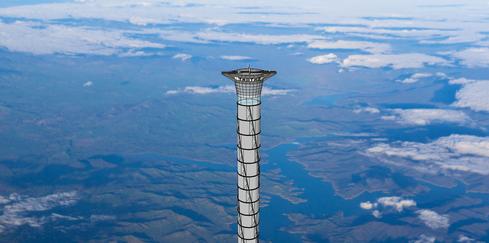A new patent has been granted for a space elevator that will reach 12 miles high, and it might be the closest we've come to a working design.


NASA's New Horizons Brings Pluto Into Focus
NASA's New Horizons Brings Pluto Into Focus (Click image for larger view and slideshow.)
The second coolest elevator concept, behind Willie Wonka's glass elevator, is the space elevator. But for the most part, we're no closer to a space elevator than we were when the idea was proposed by Konstantin Tsiolkovsky in 1895. That is, until last month when the US patent office granted a patent to Thoth Technology for creating an inflatable space elevator.
For those unfamiliar with the space elevator concept, let me explain. Rockets are extremely hard to launch off the face of the earth because of gravity and air resistance. The space elevator looks to overcome that by attaching a vehicle to a tether of one kind or another so a vehicle can climb the tether into space. It is a slower, less violent (no controlled explosions) way of getting into space.
There are now three basic kinds of space elevator concepts.
The original concept required taking a long wire into space with a counterweight on the end and attaching the other end to the equator. The natural spin of the Earth would keep the wire rigid, like when you swing something at the end of a string here on Earth. More recent concepts have involved building a slightly more rigid structure, possibly out of carbon nanotubes. In fact, a Japanese company claims it will do this by 2050, and it will extend a quarter of the way to the moon.
There are also plans that involve erecting what amounts to a large building that isn't that much different from what we build today. To do that, however, we need major breakthroughs in materials and building techniques. Here is a very pretty NASA animation done in 2000 of what a rigid space elevator would look like.
The most recent concept designed by Thoth is slightly less ambitious, but it uses technology that, for the most part, we already have (to build the building at least). It uses modular tubes of Kevlar-polyethylene composites filled with helium. The tubes are much lighter and forgiving than modern building materials, and the helium helps hold the structure up. Building it would look something like this:
OK, it would look nothing like that, but those little puppets are awesome. Here's a video of a bunch of them dancing to Taylor Swift.
Anyway, the Thoth elevator would reach about 12 miles into the air, still inside Earth's atmosphere, but high enough up that it would be much easier for spacecraft to enter space. Building a structure that is 12 miles high is hard enough. We don't really need to try building one that leaves the Earth for space. Thoth envisions using rockets, like those SpaceX is developing, that can land on a barge, servicing the International Space Station and other missions from a platform at the top of the elevator. It could save considerably on fuel and make missions much safer, because the lowered gravity would mean rockets could take off using a single-stage motor. The designer compared it with the ease of a 747 taking off.
Of course, you've got questions like, what happens if a 12-mile-tall building falls down? Good question. The answer is that things definitely won't go well. It would need to be built in a fairly remote place, but it is rather unlikely that the building would suffer a total catastrophic failure. Its modular tube design would allow for the other tubes to hold up until repairs could be made. These types of tubes are already used in space and are fairly reliable. In the event of a collapse, it would be far less damaging than a building made with current construction techniques.
One estimate is that when fully built, the elevator would weigh 880,000 tons. By point of comparison, the Empire State Building weighs 365,000 tons. It takes 45 Empire State Buildings to reach the height of the Thoth Space Elevator. That's about 20 times heavier. And I don't even want to think about what happens when a Space elevator that stretches a quarter of the way to moon fails and gravity brings it back to earth like a rubber band snapping. Or, worse, a rigid building falling from space. So of the building material options, this seems by far the safest.
Another concern is cost. The goal of a space elevator is to reduce the cost of space travel from $20,000 per ton to some more manageable number. The Japanese plan says they can reduce it to $200.
[ Cost battles have been fought and lost for a long time. Read Space X, Hubble, Coffee: The Cost of Doing Business in Space. ]
One questions the ability of a giant building to reduce costs when, for instance, I'm not sure the global helium industry would even be prepared to handle it.
Let's say just for fun that it could. The current market price of helium, is $75 per cubic foot. Assuming the elevator is 14 miles tall and has the same dimensions as the Space X landing barge (that's what they hope lands on it) it will be 300 feet by 100 feet at the top. By my calculations, the cost of the helium to fill it would be more than $14 billion. That's the cost of six Mars Curiosity Rover missions. Even assuming a bulk discount, we're talking a lot of high profile space missions before it pays for itself.
And that's not counting the cost of maintaining or repairing a building 12 miles up in the air.
There's another, more terrestrial, problem. The Space Elevator needs an Earth Elevator. Somehow, you've got to get people and materials to the top of the thing. At 12 miles, you're higher than commercial airplanes fly and much higher than helicopters fly, so everything that launches from the platform at the top has to come from an elevator on the ground.
One of the fastest elevators in the world is in the new One World Trade Center. It goes about 23 mph. That means an elevator going that speed would take over an hour to go up and then come down to take its next trip. Try taking rockets that can weigh 1 million pounds assembled, and moving the parts a few thousand pounds at a time on trips that take an hour to go up and back. And then try assembling all of that 12 miles high.
In other words we need bigger and faster elevators before we ever build a space elevator. And they need to be light enough and rigid enough to move up this thing without bringing it down. The advantage to the cable style space elevator is that its rigidity comes from the spin of the earth. The rigidity of the Thoth Elevator is in its own structure, and it has to fight gravity.
If it sounds like I'm saying this won't work, I'm not. I'm saying we've got some really big problems to overcome. Until Thoth or someone else is granted a patent for a very fast elevator that won't threaten to pull down a helium structure, we won't be building this anytime soon.
Still, it is an incredible idea and one that I think is still more feasible than the carbon nanotube string to the moon. Right now, we can make carbon nanotube chains that are as long as 3 centimeters. Only 59,652 miles to go. I'd convert that into centimeters for you, but I don’t have space for that many zeroes. Let's call it 1.4 trillion to round it off.
In other words, both technologies will require some major engineering breakthroughs. Those breakthroughs are worth investing in, not only for space travel, but for other advancements on Earth. Perhaps the faster elevator will lead to faster Earth transport. Maybe something like Elon Musk's hyperloop could be perfected first as the option for moving materials inside a space elevator. Maybe whatever new elevator is built becomes the next subway system for your town. Maybe before we build a 12-mile-tall inflatable building, we learn to build inflatable apartments that are quick to erect, inexpensive, and safe to live in even in earthquake zones.
The point is the engineering problems have "real-world" applications. So it is problem worth solving. And Thoth has the inside track on solving it first. What do you think? Will you ever ride a space elevator as part of a trip to space? Tell me in the comments section below.
About the Author(s)
You May Also Like







